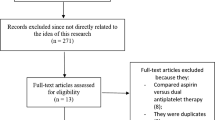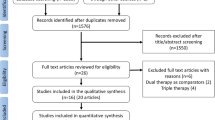Abstract
Background: While aspirin's secondary prevention benefit is clear, prior reports indicate that 19–83% of eligible patients may not use aspirin chronically.
Methods: We investigated intolerance and bleeding while on aspirin and aspirin discontinuation using 5337 post-acute coronary syndrome patients considered appropriate for chronic antiplatelet therapy who were randomly assigned to aspirin in SYMPHONY and 2nd SYMPHONY and followed for 94 (64,157) days. Multivariable logistic regression models tested associations between baseline characteristics and aspirin discontinuation and bleeding.
Results: Nearly 18% of patients discontinued study aspirin; 48% subsequently used open-label aspirin and 5% other antiplatelet or anticoagulant therapy. Black race, recurrent ischemia, hypertension, chronic obstructive pulmonary disease, lighter weight, shorter time to treatment and use of non-steroidal anti-inflammatory agents, diuretics, and digitalis were independently associated with early discontinuation. Early discontinuation was less likely in Eastern Europe, Latin America and Asia. Although major or minor bleeding was common (12.6%), only 1.0% of aspirin-treated patients were reported to discontinue due to bleeding. Gastrointestinal (10.5%) and puncture site (7.6%) were the most common bleeding locations. Bleeding risk was associated with lower estimated creatinine clearance, shorter time to treatment, smoking, Killip class >II, higher systolic blood pressure, and use of aspirin or heparin prior to starting study aspirin.
Conclusions: Despite early initiation and close follow-up, more than 9% of aspirin-treated patients discontinued therapy early and remained off treatment. Addressing the factors associated with both bleeding and discontinuation during chronic therapy is necessary to improve adherence to this inexpensive, life-saving therapy.
Similar content being viewed by others
References
Antiplatelet Trialists' Collaboration. Collaborative overview of randomised trials of antiplatelet therapy–I: Prevention of death, myocardial infarction, and stroke by prolonged antiplatelet therapy in various categories of patients. BMJ 1994;308:81-106.
Antithrombotic Trialists' Collaboration. Collaborative meta-analysis of randomized trials of antiplatelet therapy for prevention of death, myocardial infarction, and stroke in high risk patients. BMJ 2002;324:71-86.
Stafford RS. Aspirin use is low among United States outpatients with coronary artery disease. Circulation 2000;101:1097-1101.
Shahar E, Folsom AR, Romm FJ, et al. Patterns of aspirin use in middle-aged adults: The Atherosclerosis Risk in Communities (ARIC) Study. Am Heart J 1996;131:915-922.
Aronow WS. Underutilization of aspirin in older patients with prior myocardial infarction at the time of admission to a nursing home. J Am Geriatr Soc 1998;46:615–616.
Califf RM, DeLong ER, Ostbyte T, et al. Underuse of aspirin in a referral population with documented coronary artery disease. Am J Cardiol 2002;89:653-661.
Kong DF, Hasselblad V, Kandzari DE, Newby LK, Califf RM. Seeking the optimal aspirin dose in acute coronary syndromes. Am J Cardiol 2002;90:622-625.
The SYMPHONY Investigators. Comparison of sibrafiban with aspirin for prevention of cardiovascular events after acute coronary syndromes: A randomised trial. Lancet 2000;355:337-345.
Second SYMPHONY Investigators. Randomized trial of aspirin, sibrafiban, or both for secondary prevention after acute coronary syndromes. Circulation 2001;103:1727- 1733.
Newby LK, for the SYMPHONY Steering Committee. Long-term oral platelet glycoprotein IIb/IIIa receptor antagonism with sibrafiban after acute coronary syndromes: Study design of the Sibrafiban versus aspirin to Yield Maximum Protection from ischemic Heart events post-acute cOroNary sYndromes (SYMPHONY) trial. Am Heart J 1999;138:210-218.
Fonarow GC, Gawlinski A, Moughrabi S, Tillisch JH. Improved treatment of coronary heart disease by implementation of a cardiac hospitalization atherosclerosis management program (CHAMP). Am J Cardiol 2001;87:819-822.
Allen LaPointe NM, Kramer JM, DeLong ER, et al. Patient-reported frequency of taking aspirin in a population with coronary artery disease. Am J Cardiol 2002;89:1042-1046.
CAPRIE Steering Committee. A randomised, blinded, trial of clopidogrel versus aspirin in patients at risk of ischaemic events (CAPRIE). Lancet 1996;348:1329-1339.
The Clopidogrel in Unstable angina to prevent Recurrent Events Trial Investigators. Effects of clopidogrel in addition to aspirin in patients with acute coronary syndromes without ST-segment elevation. New Engl J Med 2001;345:494-502.
Derry S, Loke YK. Risk of gastrointestinal haemorrhage with long term use of aspirin: A meta-analysis. BMJ 2000;321:1183-1187.
Garcia Rodriguez LA, Hernandez-Diaz S, de Abajo FJ. Association between aspirin and upper gastrointestinal complications: Systematic review of epidemiological studies. Br J Clin Pharmacol 2001;52:563-571.
Levy G, Tsuchiya T, Amsel LP. Limited capacity for salicyl phenolic glucuronide formation and its effect on the 128 Newby et al.kinetics of sacilyate elimination in man. Clinical Pharmacology and Therapeutics 1971;13:258-268.
Levy G, Tsuchiya T. Salicylate accumulation in man. N Engl J Med 1972;287:430-432.
Levy G. Pharmacokinetics of salcilyate in man. Drug Metabolism Reviews 1979;9:3-19.
Michalak E, Walkowiak B, Paradowski M, Cierniewski CS. The decreased circulating platelet mass and its relation to bleeding time in chronic renal failure. Thrombosis and Haemostasis 1991;65:11-14.
Bloom A, Greaves M, Preston FE, Brown CB. Evidence of a platelet cyclooxygenase defect in uraemic patients on chronic dialysis. Br J Haemat 1986;62:143-149.
Zwaginga JJ, Ijsseldjik MJW, Beeser-Visser N, de Groot PG, Vos J, Sixma JJ. High von Willebrand concentration compensates a relative adhesion defect in uremic blood. Blood 1990;75:1498-1508.
Gaspari F, Vigano G, Orisio S, Bonati M, Livio M, Remuzzi G. Aspirin prolongs bleeding time in uremia by a mechanism distinct from platelet cyclooxygenase inhibition. J Clin Invest 1987;79:1788-1797.
Noris M, Remuzzi G. Uremic bleeding: Closing the circle after 30 years of controversies? Blood 1999;94:2569- 2574.
Remuzzi G, Perico N, Zoja C, Corna D, Macconi D, Vigano G. Role of endothelium-derived nitirc oxide in the bleeding tendency of uremia. J Clin Invest 1990;86: 1768.
Hogman M, Frostell C, Arnberg H, Hedenstierna G. Bleeding time prolongation and NO inhalation. Lancet 1993;341:1664.
Gries A, Bode C, Peter K, et al. Inhaled nitric oxide inhibits human platelet aggregation, P-selectin expression, and fibrinogen binding in vitro and in vivo. Circulation 1998;97:1481.
Simon DI, Stamler JS, Loh E, Loscalzo J, Francis SA, Creager MA. Effect of nitric oxide synthase inhibition on bleeding time in humans. J Cardiovasc Pharm 1995;26:339.
Radomski MW, Palmer RMJ, Moncada S. Endogenous nitric oxide inhibits platelet adhesion to vascular endothelium. Lancet 1987;328:1057.
Radomski MW, Palmer RMJ, Moncada S. An Larginine/ nitric oxide pathway present in human platelets regulates aggregation. Proc Natl Acad Sci USA 1990;87:5193.
Peters RJG, Zoa F, Lewis BS, Fox KAA, Yusuf S. Aspirin dose and bleeding events in the CURE study. Circulation 2002;106 (Suppl II): 456 (Abstr).
Henry RMA, Kostense PJ, Gos G, et al. Mild renal insuffi-ciency is associated with increased cardiovascular mortality: The Hoorn Study. Kidney International 2002;62:1402- 1407.
McCullough PA, Sandberg KR, Borzak S, Hudson MP, Garg M, Manley HJ. Benefits of aspirin and beta-blockade after myocardial infarction in patients with chronic kidney disease. Am Heart J 2002;144:226-232.
Author information
Authors and Affiliations
Rights and permissions
About this article
Cite this article
Newby, L.K., Bhapkar, M.V., White, H.D. et al. Aspirin Use Post-Acute Coronary Syndromes: Intolerance, Bleeding and Discontinuation. J Thromb Thrombolysis 16, 119–128 (2003). https://doi.org/10.1023/B:THRO.0000024050.78728.35
Issue Date:
DOI: https://doi.org/10.1023/B:THRO.0000024050.78728.35




